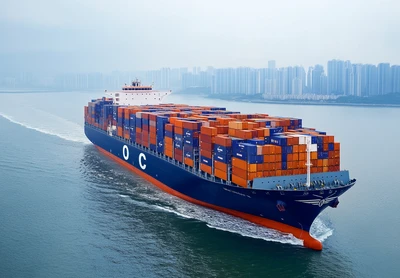
In the realm of international shipping, choosing the right logistics strategy can significantly impact the efficiency, cost-effectiveness, and overall success of transporting goods across borders. Two primary methods stand out: door to door and port to port shipping. Each method offers distinct advantages and considerations depending on the nature of the shipment, destination, and logistical requirements.

International shipping involves the transportation of goods across international borders, typically facilitated by freight carriers, logistics providers, and customs authorities. It encompasses various modes such as sea freight, air freight, and land transport.
Selecting between door to door and port to port shipping involves evaluating factors like cost, transit time, convenience, and the level of involvement required from the shipper.
Factors Influencing Shipping Method Selection
Understanding the nuances of each shipping method is crucial for optimizing supply chain management and meeting customer expectations.
Cost Considerations
Cost plays a pivotal role in determining the preferred shipping method. Door to door shipping often incurs higher costs due to the added convenience and comprehensive service provided.
Time Efficiency
Time-sensitive shipments may benefit from door to door shipping, which reduces transit times by eliminating intermediate handling and delays associated with port operations.
Convenience and Accessibility
Door to door shipping offers greater convenience as it involves end-to-end service, including pick-up at the origin and delivery to the final destination.
Definition and Scope
Door to door shipping entails the transportation of goods directly from the shipper's location to the consignee's designated destination, bypassing the need for the shipper to handle logistics beyond the initial drop-off.
Involvement of Logistics Providers
Logistics providers manage the entire shipping process, from packaging and documentation to customs clearance and final delivery, ensuring seamless transit and reduced administrative burden for the shipper.
Examples of Door to Door Services
Courier companies and specialized freight forwarders often offer door to door shipping solutions tailored to the specific needs of businesses and individual shippers.
Enhanced Convenience
The primary advantage of door to door shipping is its convenience, providing a hassle-free experience for shippers who prefer comprehensive logistics solutions without intermediary handling.
Reduced Administrative Burden
By outsourcing logistics to experienced providers, shippers can focus on core business activities while ensuring that their shipments are managed efficiently and in compliance with international regulations.
Improved Tracking and Communication
Door to door services typically include advanced tracking capabilities and regular communication updates, allowing shippers to monitor their shipments' progress in real-time.
Potential for Increased Costs
While convenient, door to door shipping can be costlier than port to port options, primarily due to additional service fees and higher transportation costs associated with direct delivery.
Customs and Regulatory Issues
Navigating customs requirements and regulatory compliance in multiple jurisdictions can pose challenges, requiring careful planning and expertise from logistics providers.
Risk Management Considerations
Ensuring the safety and security of goods throughout the entire shipping process is crucial, necessitating robust risk management strategies and insurance coverage.
Read further about CUC door to door shipping service: door-to-door shipping from China to UK, door-to-door shipping from China to USA
Definition and Scope
Port to port shipping involves transporting goods from one port of origin to another designated port of arrival, with the final delivery handled by the consignee or local logistics partners.
Role of Freight Forwarders
Freight forwarders facilitate port to port shipments by coordinating transportation, documentation, and customs clearance processes, offering flexibility in carrier selection and transit routes.
Examples of Port to Port Services
Shipping lines and freight companies specialize in port to port services, catering to bulk cargo, container shipments, and large-scale logistics operations.
Cost Effectiveness
Port to port shipping is often more cost-effective for bulk shipments and standardized cargo, leveraging economies of scale and competitive freight rates offered by shipping lines and carriers.
Flexibility in Carrier Selection
Shippers have the flexibility to choose from a wide range of shipping lines and carriers based on service levels, transit times, and cost considerations, optimizing their supply chain strategies.
Scalability for Large Shipments
Large-scale shipments benefit from the scalability of port to port shipping, which accommodates high volumes and diverse cargo types efficiently through established port infrastructure and handling facilities.
Potential for Extended Transit Times
Port to port shipping may involve longer transit times compared to door to door services, particularly when additional inland transportation is required to reach the final destination.
Complexity in Last Mile Delivery
Consignees bear responsibility for arranging last mile delivery from the arrival port to the destination, which can introduce logistical complexities and coordination challenges.
Risk of Damage and Loss
During multiple handling stages and transfers between carriers, there is a heightened risk of cargo damage, loss, or delays, necessitating comprehensive insurance coverage and risk mitigation strategies.
Decision-Making Factors
When deciding between door to door and port to port shipping, shippers should consider several critical factors to align with their business goals and operational requirements.
Type of Goods Being Shipped
The nature of goods, including size, fragility, and perishability, influences the suitability of shipping methods and required handling conditions.
Destination and Infrastructure Availability
Accessibility of infrastructure, proximity to ports, and inland transportation networks impact the feasibility and cost-effectiveness of shipping methods for specific destinations.
Urgency of Delivery
Time-sensitive shipments may prioritize door to door services for faster delivery times and reduced transit variability, whereas bulk shipments with flexible delivery timelines may opt for cost-effective port to port solutions.
Both door to door and port to port shipping methods offer distinct advantages and considerations depending on the unique requirements of international shipments. Shippers must weigh factors such as cost, convenience, transit time, and logistical complexity to determine the most suitable shipping method for their goods and operational needs.
What is the main difference between door to door and port to port shipping?
Door to door shipping involves direct delivery from the shipper's location to the consignee's destination, while port to port shipping transports goods between designated ports, with final delivery arranged by the consignee.
Which shipping method is more cost-effective for small businesses?
Port to port shipping is generally more cost-effective for small businesses shipping bulk or standardized cargo due to lower transportation costs and competitive freight rates.
How can I ensure the safety of my shipment with door to door shipping?
Choosing reputable logistics providers, ensuring comprehensive insurance coverage, and implementing robust tracking systems are essential for safeguarding shipments during door to door transport.
Are there additional taxes or fees associated with port to port shipping?
Port to port shipping may incur customs duties, terminal handling charges, and other fees depending on the destination and shipping route, which should be factored into cost calculations.
What factors should I consider when choosing a shipping method for perishable goods?
For perishable goods, prioritizing door to door shipping ensures faster transit times, temperature-controlled transportation options, and reduced risk of spoilage compared to port to port alternatives.
 How to Handle In-Transit Shipments Under New 34% U.S. TariffsApril 8, 2025Confused about the new 34% U.S. tariffs on Chinese goods? Learn how in-transit shipments are affected, calculate updated duty rates, and explore cheapest shipping from China to UK solutions with CUCFreight.view
How to Handle In-Transit Shipments Under New 34% U.S. TariffsApril 8, 2025Confused about the new 34% U.S. tariffs on Chinese goods? Learn how in-transit shipments are affected, calculate updated duty rates, and explore cheapest shipping from China to UK solutions with CUCFreight.view How a Misprinted Invoice Made Me Rethink China-UK Shipping (And Saved My Business £27k)April 7, 2025Bristol importer spills the tea on cutting logistics chaos - from customs meltdowns to courier cons. CUCFreight's unorthodox hacks inside.view
How a Misprinted Invoice Made Me Rethink China-UK Shipping (And Saved My Business £27k)April 7, 2025Bristol importer spills the tea on cutting logistics chaos - from customs meltdowns to courier cons. CUCFreight's unorthodox hacks inside.view Sod HS Codes, Let’s Talk Proper China ShippingMarch 24, 20251: When the Bollocks Hit the Container“Bloody hell, they’ve classed our hinges as ‘furniture parts’ again!” I yelled at the customs letter, which demanded £2,800 for “luxury goods storage” – ...view
Sod HS Codes, Let’s Talk Proper China ShippingMarch 24, 20251: When the Bollocks Hit the Container“Bloody hell, they’ve classed our hinges as ‘furniture parts’ again!” I yelled at the customs letter, which demanded £2,800 for “luxury goods storage” – ...view Top 50 Freight Forwarders Shipping from China to the USA 2024November 4, 2024In the fast-paced world of global trade, choosing the right freight forwarder can make or break a business's logistics operations. With the growing demand for goods from China to the USA, selectin...view
Top 50 Freight Forwarders Shipping from China to the USA 2024November 4, 2024In the fast-paced world of global trade, choosing the right freight forwarder can make or break a business's logistics operations. With the growing demand for goods from China to the USA, selectin...view